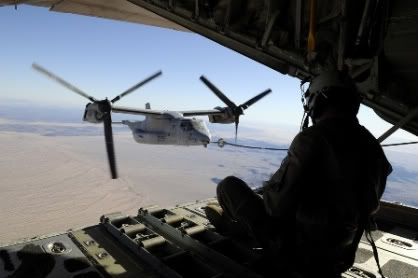WHO CAN BLAME the Osprey for having a military-indus- trial complex? Since the abysmal failure in 1980 of the Iranian hostage-rescue attempt (aka, Jimmy Carter's Desert Classic), efforts to develop an aircraft that can fly long distances like a transport plane, yet hover, take off, and land like a helicopter, have been failure-fraught and hugely expensive. But the ungainly bird, used mainly by the Marines, may now prove its worth in Afghanistan.
 An MV-22 Osprey spreads its wings over Yuma, Ariz., in 2009. The controversial aircraft has now entered the war in Afghanistan.
An MV-22 Osprey spreads its wings over Yuma, Ariz., in 2009. The controversial aircraft has now entered the war in Afghanistan. If so, it's high time--because tragedy and fiscal folly have long haunted the Bell-Boeing V-22 Osprey, as the tilt-rotor craft is officially known.
Between 1992 and 2000, three test crashes of the hard-to-fly, technically troubled hybrid killed 30 people. The first crash occurred in Fredericksburg's backyard when, to the horror of congressmen and others watching from Quantico Marine Corps Base, an Osprey plummeted into the Potomac River, killing all seven aboard. An even more terrible accident took place in Arizona in April 2000 when, during a simulated rescue mission, an Osprey loaded with Marines dropped out of the sky, killing all 19 on board. Eight months later a V-22 mechanical glitch in Jacksonville, N.C., claimed a four-man crew, including Lt. Col. Keith Sweaney of Stafford County, who was to have led the Corps' first Osprey squadron.
The Osprey's cost overruns form a parallel disaster. In 1988, then-Defense Secretary Dick Cheney tried to kill the whole program after its development budget had ballooned from $2.5 billion to $30 billion, but Congress blocked him. Now, some $54.2 billion will have been spent on the bird before its evolution is complete--an inflation caused by re-engineering requirements and unforeseen maintenance demands.
Moreover, in Iraq, where 12 Ospreys flew from 2007-09, the craft's performance drew jeers from the Government Accounting Office for mediocre performance. This isn't what one wants to hear about a craft that costs $120 million each to put into battle.
But the Marines, who stand by their awkward transport, believe that in sprawling, rugged Afghanistan the Osprey will show its mettle. It may. The aircraft is so fast, notes military.com, that it can make two round trips for every one a helicopter can complete, dropping up to 32 troops or 71/2 tons of material in a combat zone--say, the Now Zad Valley of Helmand Province.
There, in the first big offensive since President Obama's Dec. 1 speech, 10 Ospreys are dodging Taliban bullets while supplying over 1,000 Marines and allied troops that they earlier helped ferry to the valley during "Operation Cobra's Anger." (Iraq's Ospreys arrived in Anbar Province just as the "Sunni Awakening" was cooling that place, so the craft's combat-effectiveness was hard to judge.) Lt. Gen. George Trautman III, the Marines' deputy commandant for aviation, says that the swift Osprey has turned the Afghan battle space "from Texas into Rhode Island."
In ancient times, people believed that the mere sight of the bird of prey from which the Marine aircraft takes its name caused fish to go belly-up. One doubts that the V-22 will have the same effect on Taliban fighters. But if the Osprey crucially helps the U.S. prevail in that difficult war, the plane will have earned its exceedingly costly wings.
No comments:
Post a Comment